Part 7: British Railways - The Diesel Era (continued)
One other type which occasionally appeared at Cambridge was the Derby Class 125 hydraulic units. These had a unique 'orange star' coupling code and thus were incompatible with the other DMU types. They had been built for the Lea Valley lines which at the time were not electrified and could also be seen on, for example, the Buntingford and Southminster branches. With eventual electrification of the Lea Valley lines, the 125s were sent to work, or try and work, on the King's Cross suburban services. They were notoriously troublesome and BR ridded itself of them as soon as the first stage of the Great Northern electrification scheme came into operation. Despite working out of King's Cross the 125s continued to be maintained / repaired at Stratford. Generally kept on services at the London end of the GE and GN routes, they were nevertheless seen at Cambridge from time to time with their Rolls-Royce engines growling away accompanied by the constant hissing sounds of air pressure relief valves.
There was a couple of individual Cravens cars around Cambridge worth a mention. One was E50249; this was always listed as a driving motor brake for a 4-car unit, but there never were any 4-car Cravens sets. E50249 was numbered in the middle of a block of Metro-Cammell cars and was said to have been a replacement for a Metro-Cammell car E50173, part of a 4-car set, which was written off after an accident at Hexham when still almost new. E50249 is known to have been sent new to the north-east but was quickly moved to East Anglia where it spent the rest of its career. The reason a Cravens car was ordered to replace a Metro-Cammell was probably due to factory capacity at the time. E50249 was certainly built as one-off as it was the only car built under lot number 30505. Other details, such as what eventually replaced the damaged Metro-Cammell car, remain something of a mystery. Also, E50173 did not have a brake compartment, this being in another vehicle of the 4-car sets, whereas E50249 did. This might suggest the use of E50249 as a replacement for the Metro-Cammell was only ever intended to be temporary.
The second car worth a mention was E56443, a diving trailer. This had been repainted from green into one of the early experimental versions of BR blue and was given small numbers and a small yellow warning panel. It ran around for quite some time like this before eventually receiving Rail Blue and a full yellow end. The early blue livery did not sit well on E56443 at all and looked even worse when paired with a green power car.
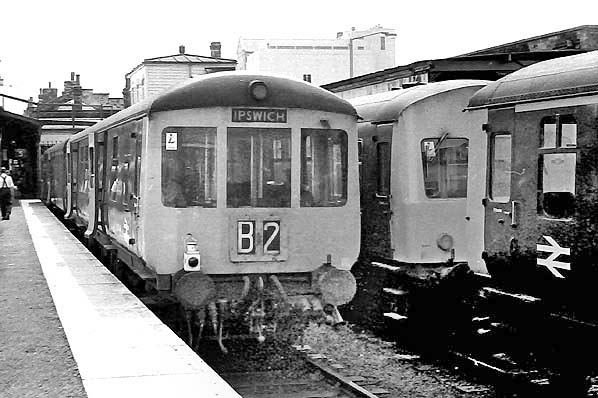
Photo by Alan Brown
Above, it is January 1970 and Cravens are nowhere to be seen. They will, however, be around somewhere waiting to rasp loudly as some unsuspecting person walks past. In the north bay we can see Gloucester RC&W Class 100 and Metro-Cammell Class 101 DMUs. As can be seen, the 'blue square' symbol on the cab fronts tended to fade into almost invisibility and in later years the 'blue square' tended to be omitted altogether and LW simply stenciled in black direct onto the yellow. Class 100 was not native to the area; from new they were allocated to the London Midland and Scottish regions. They were among a number of DMUs drafted in to replace the 'yellow diamond' sets. They had a body tumblehome which met the very exposed solebars and although this was neat it gave a rather quaint appearance. The interiors featured much highly varnished woodwork while the seats had pronouncedly curved backrests. The tail lamp and open doors suggests the unit has just arrived at platform 5. The unit is a hybrid and the Class 100 car appears to be coupled to a BRCW Class 104 car.
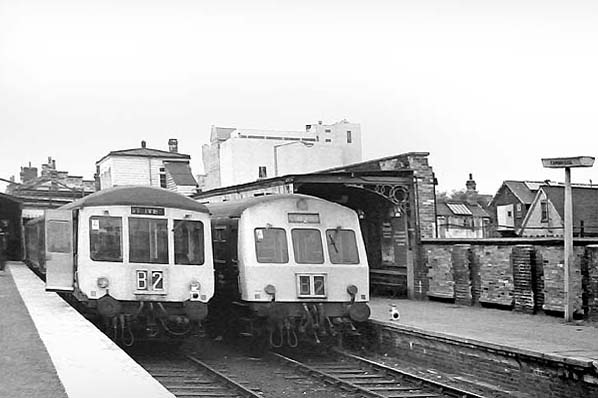
Photo by Alan Brown
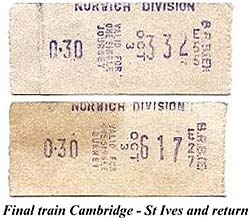 On the same day in January 1970 and still at the north bay, we see a Class 100 at platform 5 and a Class 101 at platform 6. The tail lamp on platform 6 will be transferred to the other end of the Metro-Cammell, while the tail lamp on the Gloucester unit is still in place. The B2 headcode now predominates. The area of the former steam shed, demolished three years previously, looks rather forlorn but the platform light still informs passengers they are at Cambridge. The Gloucester Class 100 will operate the 13:10 to St Ives, see timetable below. The passenger service was withdrawn in October that year; the final train being a mixed 4-car DMU (strengthened from the usual 2-car) formed of Gloucester, Metro-Cammell and Cravens cars. This was the 21:28 SO service which normally returned to Cambridge non stop but on the last day, 3 October, it called at all stations so people along the route could travel on the last train and get home again. It was a nice gesture, or would have been if BR had bothered to advertise it properly; many people watching along the route did not know the 22:00 from St Ives was going to stop until it actually did so.
On the same day in January 1970 and still at the north bay, we see a Class 100 at platform 5 and a Class 101 at platform 6. The tail lamp on platform 6 will be transferred to the other end of the Metro-Cammell, while the tail lamp on the Gloucester unit is still in place. The B2 headcode now predominates. The area of the former steam shed, demolished three years previously, looks rather forlorn but the platform light still informs passengers they are at Cambridge. The Gloucester Class 100 will operate the 13:10 to St Ives, see timetable below. The passenger service was withdrawn in October that year; the final train being a mixed 4-car DMU (strengthened from the usual 2-car) formed of Gloucester, Metro-Cammell and Cravens cars. This was the 21:28 SO service which normally returned to Cambridge non stop but on the last day, 3 October, it called at all stations so people along the route could travel on the last train and get home again. It was a nice gesture, or would have been if BR had bothered to advertise it properly; many people watching along the route did not know the 22:00 from St Ives was going to stop until it actually did so.
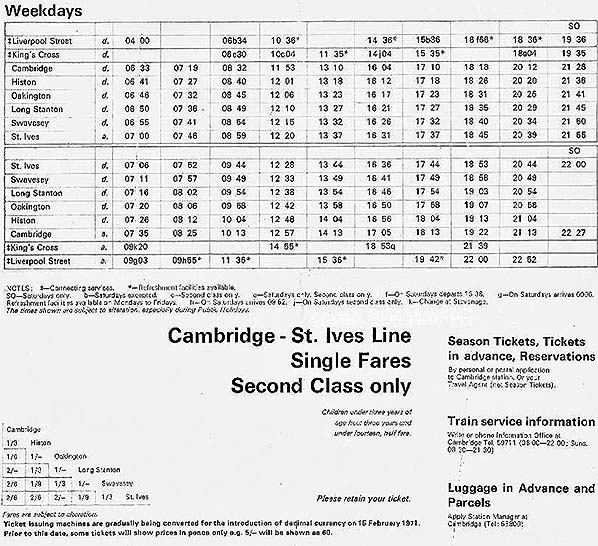
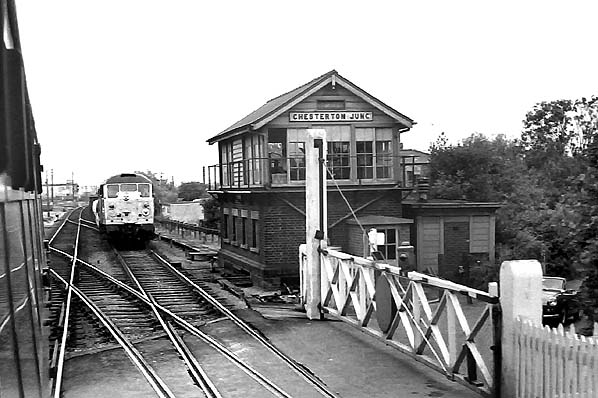
Photo by Alan Brown
Above, a view from the train as seen in the previous image of the north bay as it branches off at Chesterton Junction bound for Histon and St. Ives as a 'skinhead' Class 31 approaches with an up goods from the Ely direction. The DMU has just crossed the bridge over the River Cam; this is the third bridge at this site and dates from 1931. Chesterton Junction box was originally south of the level crossing, between the road and the river. Just beyond the junction, the St. Ives line, which was then double track, also had up and down goods loops as well as access to the permanent way (PW) depot. One of the gantries of the PW depot can be seen in the left background. There had been sidings on the site since the 19th century but the modern PW depot dated from BR days. Today, having been derelict for many years apart from a siding used as a freight train refuge, the site is being developed for the new station serving the north of Cambridge which should open in late 2016.
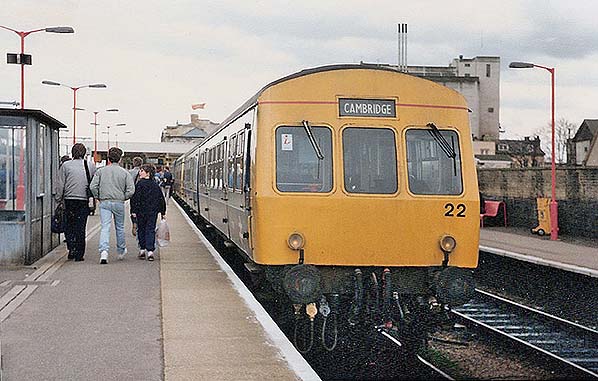
Photo by MIchael Day reproduced from Wikimedia Commons under creative commons licence
We now jump ahead to April 1987 when refurbished Cambridge-based Metro-Cammell Set 22 idled away in platform 5. By this time, most DMUs seen at Cambridge had set numbers prefixed with the letter L, for London area. These Cambridge Class 101s had set numbers applied locally and for local convenience. The units had been allocated to Cambridge as a stopgap following the second phase of the Great Northern suburban electrification. The units operated the Cambridge - Royston and Hitchin - Huntingdon shuttles but also turned up on other services, hence the unit above being in platform 5. Evidence of Network SouthEast is visible in the form of the new platform lighting.
At this time, obviously, the north bay of Cambridge station was not electrified. The south bay and platforms 1 and 4 were wired, as can just be seen on the left, and the wires ended at Coldhams Lane. The north bay was wired at some point after the line north of Cambridge was electrified in the 1990s and electric trains leaving the stabling sidings use the bay for reversing before heading north, either empty stock or in service. An example of the latter is an afternoon service from Cambridge to Downham Market which then returns south to King's Cross.
Another of the many DMU types once seen at Cambridge was the class of just five Wickham units, later Class 109. D. Wickham & Co. of Ware, Hertfordshire, were famous for their small motorised platelayer / inspection trolleys but they were once somewhere near the forefront of lightweight railcars which they exported to, perhaps most famously, South America. The firm was also something of a pioneer of monocoque construction, meaning that no conventional underframe is used and strength is designed into the body structure. Wickham built six railbuses for BR, five passenger and one departmental, but were keen to get a slice of the cake when BR began mass ordering of DMUs. However, at this point it is unclear if Wickham pressured BR, or rather the BTC, into placing an order or if BR / BTC were keen to evaluate monocoque construction. What is known, and well known at that, is that manufacturers were given a general specification but otherwise allowed a free hand. In the light of this it was probably Wickham who pushed for an order rather than any specific interest from the BTC or BR. With Wickham being a relatively small firm, there is also some evidence that BR was concerned about the manufacturing capacity of the Ware factory. Whatever the true story might be, the outcome was the five 2-car units of what became Class 109.
Class 109 was perhaps most famous for its unusual vestibule draught screens which provided a balloon-shaped opening through the vestibules. Driving cabs had a rebated desk for the driving position with an angled instrument panel neatly positioned in front of the driver. For the time, this arrangement was very modern but any hint of modernity was then lost by the brake valve which was not desk-mounted but of a similar style to that found in 79xxx Derby Lightweights.
The side elevation of the Wickham cars was a little odd because of the door droplights. It was usual on any rolling stock for door droplights to be shallower than the sidelights (passenger windows) but most manufacturers designs placed all lights on a common centreline for aesthetic reasons. Wickham thought otherwise and placed the top of the door droplights in line with the top of the sidelights and the result looked odd and as if the wrong doors had been fitted. The Derby-built Class 108 was the same and looked similarly odd. The cab design itself was also rather odd, or perhaps over-elaborate. On their railbuses for BR, Wickham used a 2-piece windscreen arrangement but the Class 109s had a 3-piece arrangement with a narrower centre section. Possibly this came about due to the monocoque frame design. Guttering curved downwards on the roof dome to more or less meet the centre windscreen but the quite pleasing effect this provided was rather spoiled by the destination box which would have looked better slightly higher up. This would have also allowed the cream band below the cantrail to run continuously round the ends of the cars. The headcode also looked a little odd, being two boxes spaced wider apart than on other DMUs but this may also have been necessitated for body structure reasons.
The five units comprising Class 109 were E50415-9 / E56170-4 and their entire careers in BR passenger service were spent in East Anglia. Originally Cambridge based, the survivors ended up under the Norwich division and thus were Norwich based but as with the other units so-transferred the Wickhams continued to be seen in same haunts of previously. Two Wickham units had mere four year careers with BR. In 1961 the Trinidad Government Railways had a requirement for some lightweight diesel railcars and Wickham took the bait, buying back E50415 / E56170 and E50419 / E56174 for export to Trinidad.
Basking in the Caribbean sunshine, the Wickham units were fitted with steps for use at the low platforms, were given the monogram of their new owners and steam-style numbers were painted onto the unusually deep bufferbeams but otherwise the units were unchanged and even retained the 'whiskers' and headcode boxes. Their final use was on the Port of Spain - Arima service when the Trinidad Government Railways finally closed down in September 1968 after a protracted rundown over the previous fifteen or so years. The Wickhams did not operate the last train to San Fernando as is often claimed, that dubious honour fell to steam locomotive 27 on 30 August 1965. The song Last Train to San Fernando dated from 1957 and is a mere romanticism having no apparent historical connection to any of the San Fernandos dotted around the world.
Trinidad, of course, was no stranger to British products and there were also a number of Hunslet diesel shunters very similar to BR Class 05 on the sugar plantation systems and at least one Sentinel steam railcar also operated on the island.
The Wickhams in Trinidad must have been unbearably hot inside but at least this would have put an end to the saloon heating problem which plagued all BR First Generation DMUs. Heating was of the Smiths-Webasto type and had two heat settings; low and high. The burners were unreliable on the low setting so tended to be switched onto high - and left there. It was for this reason BR's DMUs always seemed stifling hot inside when the heaters were in use.
In Trinidad the Wickhams were photographed dumped on a siding in 1970 and two, at least, of the Wickham cars were spotted some years later in grounded body form and in use as dwellings. There have been no known reports of them since.
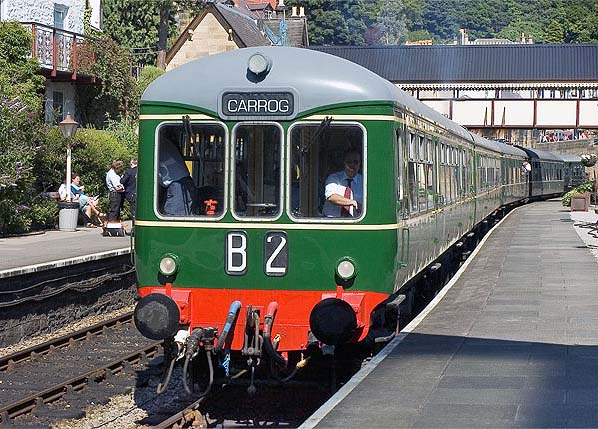
Photo by Mark Riley, reproduced from Geograph under creative commons licence
Of the three units which remained with BR, one was converted in 1967 to the Eastern Region general manager's saloon. The unit was heavily modified for its new role but it survived to be preserved. Above is a splendid view of the fully restored E50416 / E56171 at Llangollen and it must be said that considering the state the unit was in when acquired for preservation, a fantastic job of restoration has been done. This unit is the one which operated the last train on the Mildenhall branch on 16 June 1962.
The remaining two Wickham units received blue livery and continued in passenger service until 1971. They were a regular sight in the Cambridge area. When describing the 'yellow diamond' units we mentioned the 'max speed 65 mph' notice in the cabs. For reasons unknown the Wickham units also once had this notice, despite being mechanically the same as most other diesel-mechanical types. It is understood the preserved unit now has the normal 70 mph notice in its cabs. Perhaps it was something to do with lightweight units, yet Cravens were lightweights but always had the 70 mph notice in their cabs.
The two Wickham units which survived in BR passenger service were victims of line closures in the years preceding their withdrawal and BR also classed them as 'non standard'. It is hard to say what BR actually classified as standard' because DMUs from different manufacturers, despite being to the same basic specification, all differed in some way or another. The Wickhams were reliable, there was no reason for them not to be, and did not suffer the rattles and vibrations other types were prone to but is had been said BR were wary of the monocoque construction due to repairs to damage being expensive. Perhaps this was true at the time but today most railway passenger vehicles are built using this method so it could be said the Wickhams had the last laugh.
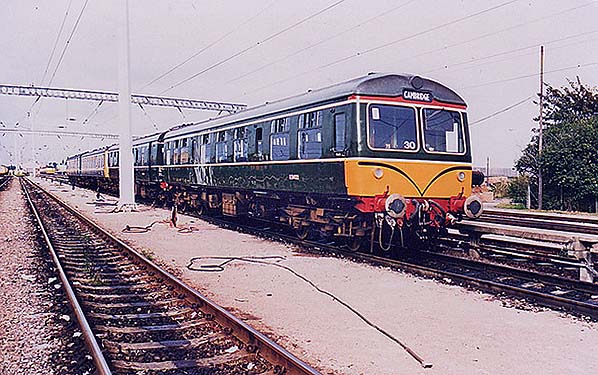
Photo
by Pat Newson from Cambridge area 1980s Flickr photostream
Towards the end of the Cravens lives one set was repainted into a representation of original livery and had something of a celebrity status. Here it is at Cambridge on an unknown date during the 1980s. It was shame about the cab ends; an original style of yellow panel without the unauthentic 'whiskers' would have looked much better or even no yellow panel but with original style 'whiskers' and a high-intensity headlight to comply with regulations. Never mind though, BR deserved credit for these little historical gestures even if there were compromises.
The Experimental Diesel-Electric Unit
This unit, which appeared at Cambridge back in 1957, is worth a mention. It was built at Derby in 1956 from two ex-LMS brake second coaches M9821M and M9828M for the purpose of trials with underfloor diesel-electric equipment. It never ran in passenger service, nor was it intended to. Motor bogies from withdrawn Euston - Watford DC electric stock were fitted and beneath the floor of each car was slung a Paxman 6ZHXL horizontal engine driving a British Thomson-Houston main generator. The engines were the same type as fitted to the Clayton Type 1, Class 17, but were not supercharged as in the Claytons. It is interesting to note that these engines gave no trouble whatsoever in the experimental units five years of trials during which a considerable mileage was clocked-up.
The experimental unit retained the numbers 9821/8 but without the prefix and suffix letters. Driving cabs with three-piece windscreens were built into each end and the unit was given the then standard lined green DMU livery complete with 'whiskers'. A single electric marker light was fitted at the top-centre position on each end.
The unit ran trials in a number of areas including on the main lines to Euston, King's Cross and St Pancras, the Settle - Carlisle line, the Lickey Incline, the Leeds / Bradford and Liverpool / Manchester areas and East Anglia. On 29 July 1957 it ran a circuit from Norwich to Ipswich via Lowestoft and Beccles returning via Beccles, Yarmouth South Town and Lowestoft. The following day saw it at Cambridge; it ran to Cambridge from Norwich, then to Ely and Peterborough East before returning to Norwich via the Ely loop.
The unit appears to have been entirely successful but BR are said to have rejected the design due to its cost and weight. But cost and weight should have been known way back when the unit was still at the design stage, so it is more likely that BR simply lost interest due to the floods of diesel-mechanical multiple units by then coming in and proving to be successful. The Southern Region, of course, had a large fleet of diesel-electric multiple units but these were totally different in that they were based largely upon DC electric multiple unit designs with a generating plant installed above the floor. The 9821/8 project seems to have been abandoned at the end of 1962 and the unit scrapped.
Experimental Railbus LEV1
It has been a little difficult knowing where to describe LEV1 as it was not a DMU and most definitely does not belong in the Waggon und Maschinenbau section. LEV1 (Leyland Experimental Vehicle 1) was one a several such contraptions based upon the Leyland National Mk2 road bus. The culmination of these experiments was the Pacer fleets of DMUs or, if you prefer, Nodding Donkeys. One of the prototypes was actually built by D. Wickham & Co.
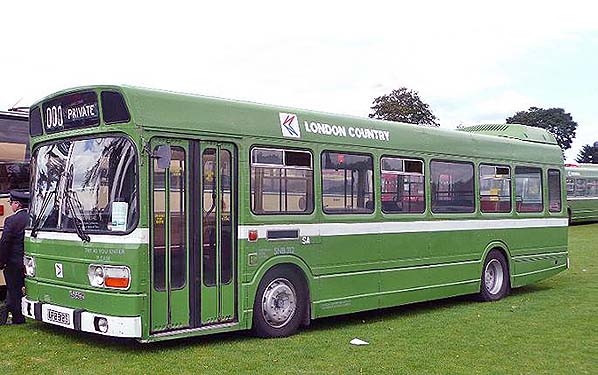
Photo by Arriva436 reproduced from Wikimedia Commons under creative commons licence
Above, at a bus rally at Alton in 2008 we see smartly preserved ex London Country Leyland National Mk1 SNB 312. This was the type of bus LEV1 was based upon. The prototype railbuses were little more than a double-ended version of the road bus body plonked onto a railway wagon underframe.
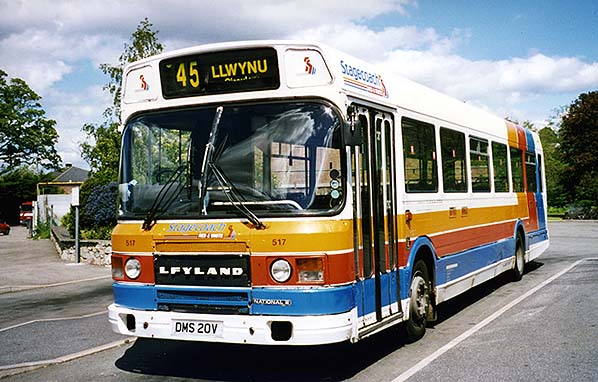 Photo by Gordon Cragg reproduced from Wikimedia Commons under creative commons licence
Photo by Gordon Cragg reproduced from Wikimedia Commons under creative commons licence
Above we see a Leyland National 2 bus owned by Stagecoach at Abergavenny in May 1997. Some of the experimental railbuses built subsequent to LEV1 had the 'National 2', as it was known, style of front end.
The original idea behind these railbuses was apparently export orders but there were political goings-on in respect of the domestic market. BR was pushing for a new DMU fleet but government was looking for ways to keep the Leyland National bus plant at Workington in operation. The outcome, in a nutshell, was that BR could have its new fleet providing a percentage of it came from Workington and the ultimate result, as mentioned, was the Pacer fleet, the Class 155 and the Class 153 conversions from the latter. The Class 155, however, was of much more conventional railway construction rather than simply an adapted bus body on railway wheels.
The Leyland National bus body was not, for a number of reasons, suitable for railway use and a major concern was crash worthiness - or lack of it. In the 1970s this was not so great a concern as it is today but, even so, BR recognised this and other issues with the Leyland National bus body and the result was the Class 140 and 141 designs which in turn morphed into Classes 142/3/4.
LEV1 first appeared in 1978 but in unpowered form. The Railway Technical Centre, Derby, played around with it in this form until 1979 when it was 'upgraded' into a powered vehicle. The engine was a Leyland 510, as used in the Mk1 Leyland National bus. It was a horrible engine; noisy, smokey, difficult to start in cold weather even with glow-plugs, high on fuel consumption and expensive to maintain due to having no separate cylinder heads. On the plus side, once the 510 got going it was nippy and the Mk1 bus was quite happy out on the open road.
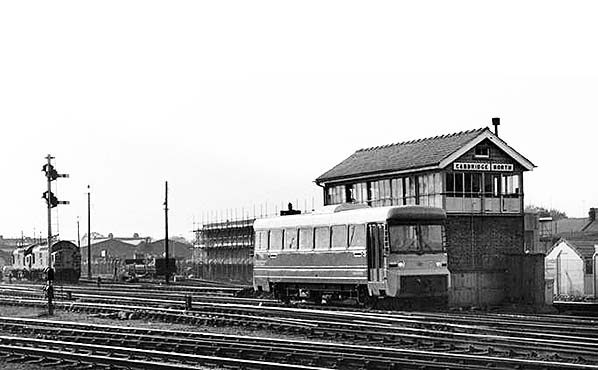
© Chris Burton
LEV1 ran in passenger service in East Anglia for a time and is best remembered for bouncing and lurching along the East Suffolk Line, often shadowed by a DMU supposedly for capacity reasons. The railbus is seen above sneaking past Cambridge North box on 1 November 1980 - see below.
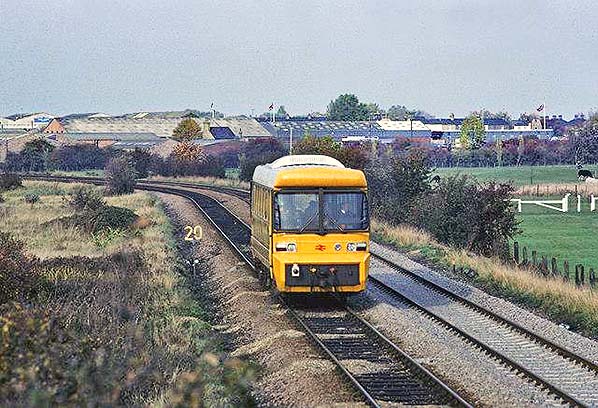
Photo by Ian Capper reproduced from Geograph under creative commons licence
Above, we see LEV1 in Cambridge and about to take the sharp curve off the Newmarket line to Coldham Lane Junction. This image is dated simply October 1980 and LEV1 is returning to Cambridge from Bury St Edmunds on a private charter. The black and white image is dated 1 November 1980 but the two images are thought to depict the same charter, in which case we have a date problem. Alternatively the black and white image may show LEV1 on a different occasion. LEV1 was in the yellow livery seen above for all its life as a powered vehicle, if not its entire life.
At some point in late 1980 LEV1 was sent to the USA for evaluation before returning in 1986. It is now part of the National Collection and has operated on several heritage railways. Another, the Wickham vehicle with 'National 2' cabs and referred to as LEV2 or R3, was built for - and went to - the USA and remains there at the time of writing. A further example, again with 'National 2' cabs, was regauged and sent to Northern Ireland Railways. The railbuses with Class 141 type cab ends also survive on heritage railways.
Whether Leyland and BR really hoped export orders would come about with the LEVs or if the whole affair was a political seen to be doing something stunt supposedly to keep Leyland's Workington plant going is a question we will probably never know the answer to. There is a very fine dividing line between running these 4-wheel railbuses with their many limitations and simply deciding it is easier and cheaper to give up and operate road buses instead. In effect this was the usual outcome of the 1950s railbuses and a lesson which, one would have thought, would have been learned from. Around the world there are vast tracts of sparsely populated areas which may only see the occasional freight train and such places provide a niche for small, cheap railbus type vehicles as once proved the case with the quite successful but somewhat comical 'American Galloping Goose' railcars. But really, the concept of the 4-wheeled passenger railcar using adapted road vehicles or road vehicle components is a chapter from the pages of history and that is arguably where it should remain.
The Pre Nationalisation Buffet Cars and BR Prototype Stock
This subject has proved to be another for which photographs taken at Cambridge have been extremely difficult to find or, when they have, permission to use them has not been forthcoming. We are including these vehicles in Part 7 simply because most photographs of them in service show them in BR blue / grey livery and this, of course, is the period in which they became most well known at Cambridge.
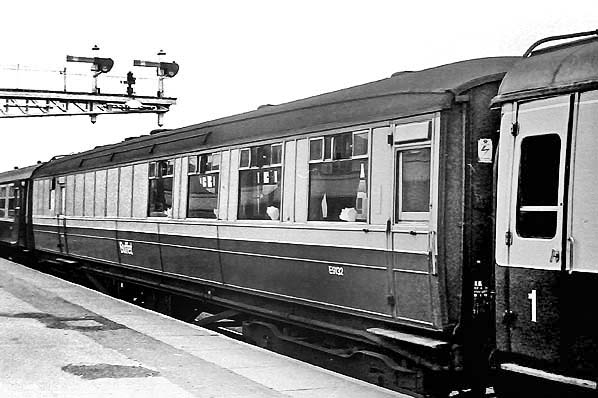
Photo by Alan Brown
Referring to the earlier image of D3634, the above view very probably shows the same train seen at the platform. In 1937 a batch of six Gresley buffet cars were built specially for Cambridge services but they were merely part of a much larger fleet which could be seen anywhere from London to Scotland. In BR days the Gresley buffets were usually associated with the Cambridge 'Buffet Express' for which there was two sets of coaching stock, one based at each end of the route. E9132, seen above, was one of several Gresleys which were juggled around on these services. Others were E9115E, E9121E, E9131E and E9135E. E9132 was one of a small few that did not carry the E suffix. Prefix and suffix letters were a BR method of distinguishing pre-nationalisation stock; the prefix donated the region the vehicle operated on and the suffix denoted the region, or company, of origin. To give an example, Gresley E9135E was later transferred to the Western Region and was renumbered W9135E.
The Gresleys worked turn and turn about with the Thompson cars mentioned earlier, E1705E and E1706E. These vehicles continued to be seen, on and off, at Cambridge almost until the end of locomotive hauled services on the King's Cross line but BR Mk1 buffet cars became more and more common. They were then transferred elsewhere as already mentioned with a least one of the Thompsons migrating to Scotland where it received the SC prefix to its number. These two surviving Thompsons, if we discount the ex-LT tube stock on the Isle of Wight, went on to become the last pre-nationalisation passenger stock on BR. They finally bowed out in 1979. They were also the last stock, again discounting the Standard tube stock then running on the Isle of Wight, to have door droplights operated by leather straps (the Standard tube stock used these straps on the interconnecting doors). The Gresleys and the Thompsons, the latter dating from 1947, both had hints of 1930s design internally but generally their interiors were quite austere. One of their plus points was their smooth running, due to being mounted on Gresley bogies. Both of the Thompson cars survived into preservation as did most, if not all, of the late-surviving Gresleys.
Liverpool Street services generally used BR Mk1 buffet cars but the surviving Gresley and Thompson cars could also appear on these. Apparently these were positioning moves as the cars became due for maintenance but specific details are not known.
 Another unusual vehicle which appeared at Cambridge from c1972 was the 'Booth Car' E1106. This was an experimental BR Mk1 vehicle built in 1962 and was destined to remain the only example of its type. It was distinguishable by having one side virtually all panelled and the other side windowed for its entire length between the doors. Internally it had a kitchen and seating similar to that in an ordinary open carriage, with tables, arranged along and slightly off-centre of the cars centreline. On one side of the seating was the passenger access while on the other side was a narrower staff gangway for serving passengers. The seating, arranged four per table, was known as 'booths'. The car was branded 'Restaurant'. E1106 appeared on Cambridge 'Buffet Express' services but also on Liverpool Street - King's Lynn services, a duty to which it was more suited. It too has survived into preservation.
Another unusual vehicle which appeared at Cambridge from c1972 was the 'Booth Car' E1106. This was an experimental BR Mk1 vehicle built in 1962 and was destined to remain the only example of its type. It was distinguishable by having one side virtually all panelled and the other side windowed for its entire length between the doors. Internally it had a kitchen and seating similar to that in an ordinary open carriage, with tables, arranged along and slightly off-centre of the cars centreline. On one side of the seating was the passenger access while on the other side was a narrower staff gangway for serving passengers. The seating, arranged four per table, was known as 'booths'. The car was branded 'Restaurant'. E1106 appeared on Cambridge 'Buffet Express' services but also on Liverpool Street - King's Lynn services, a duty to which it was more suited. It too has survived into preservation.
One other oddity also appeared at Cambridge for a time during the late 1960s / early 1970s. In 1957 BR and contractors built a batch of fourteen experimental Mk1 coaches to test new styles and fittings. These are not to be confused with the XP64 stock. One of the 1957 coaches, Open First E3082 built by Cravens Ltd., put in appearances on services between Cambridge and the Midlands. In maroon livery, its external appearance was otherwise vaguely similar to a Blue Pullman kitchen car. E3082 had venetian blinds and rotating seats but your authors memory, which may not be reliable, says the seats also reclined and the coach had been downgraded to Second class. Any further information on E3082 and its appearances at Cambridge would be appreciated.
Depot Staff
Some records from the end of 1964 are available for Cambridge depot. At this time there were 136 drivers; 46 passed firemen; 57 firemen; 20 passed cleaners and 99 maintenance staff (this was, of course, some 2½ years after 31A closed to steam but a time when firemen were still referred to as such and before the secondman' grade was officially introduced). At this same time, 1964, there were 13 diesel shunters allocated and 31 diesel multiple units and there were 10 shunter diagrams. This diagram total would have excluded those at Chesterton Junction and the St. Ives / Huntingdon East and Saffron Walden pilots which had been withdrawn by this time.
Cambridge depot, at this time, was relatively small compared to others in the area. For example, Stratford had 477 drivers; Finsbury Park 280 drivers; March 253 drivers and New England 219 drivers.
Tickets Darren Kitson except 6158 Michael Stewart. St Ives timetable Darren Kitson.
Click here for Part 8: Electrification and the
end of British Rail or return to Cambridge home page




 On the same day in January 1970 and still at the north bay, we see a Class 100 at platform 5 and a Class 101 at platform 6. The tail lamp on platform 6 will be transferred to the other end of the Metro-Cammell, while the tail lamp on the Gloucester unit is still in place. The B2 headcode now predominates. The area of the former steam shed, demolished three years previously, looks rather forlorn but the platform light still informs passengers they are at Cambridge. The Gloucester Class 100 will operate the 13:10 to St Ives, see timetable below. The passenger service was withdrawn in October that year; the final train being a mixed 4-car DMU (strengthened from the usual 2-car) formed of Gloucester, Metro-Cammell and Cravens cars. This was the 21:28 SO service which normally returned to Cambridge non stop but on the last day, 3 October, it called at all stations so people along the route could travel on the last train and get home again. It was a nice gesture, or would have been if BR had bothered to advertise it properly; many people watching along the route did not know the 22:00 from St Ives was going to stop until it actually did so.
On the same day in January 1970 and still at the north bay, we see a Class 100 at platform 5 and a Class 101 at platform 6. The tail lamp on platform 6 will be transferred to the other end of the Metro-Cammell, while the tail lamp on the Gloucester unit is still in place. The B2 headcode now predominates. The area of the former steam shed, demolished three years previously, looks rather forlorn but the platform light still informs passengers they are at Cambridge. The Gloucester Class 100 will operate the 13:10 to St Ives, see timetable below. The passenger service was withdrawn in October that year; the final train being a mixed 4-car DMU (strengthened from the usual 2-car) formed of Gloucester, Metro-Cammell and Cravens cars. This was the 21:28 SO service which normally returned to Cambridge non stop but on the last day, 3 October, it called at all stations so people along the route could travel on the last train and get home again. It was a nice gesture, or would have been if BR had bothered to advertise it properly; many people watching along the route did not know the 22:00 from St Ives was going to stop until it actually did so.








 Another unusual vehicle which appeared at Cambridge from c1972 was the 'Booth Car' E1106. This was an experimental BR Mk1 vehicle built in 1962 and was destined to remain the only example of its type. It was distinguishable by having one side virtually all panelled and the other side windowed for its entire length between the doors. Internally it had a kitchen and seating similar to that in an ordinary open carriage, with tables, arranged along and slightly off-centre of the cars centreline. On one side of the seating was the passenger access while on the other side was a narrower staff gangway for serving passengers. The seating, arranged four per table, was known as 'booths'. The car was branded 'Restaurant'. E1106 appeared on Cambridge 'Buffet Express' services but also on Liverpool Street - King's Lynn services, a duty to which it was more suited. It too has survived into preservation.
Another unusual vehicle which appeared at Cambridge from c1972 was the 'Booth Car' E1106. This was an experimental BR Mk1 vehicle built in 1962 and was destined to remain the only example of its type. It was distinguishable by having one side virtually all panelled and the other side windowed for its entire length between the doors. Internally it had a kitchen and seating similar to that in an ordinary open carriage, with tables, arranged along and slightly off-centre of the cars centreline. On one side of the seating was the passenger access while on the other side was a narrower staff gangway for serving passengers. The seating, arranged four per table, was known as 'booths'. The car was branded 'Restaurant'. E1106 appeared on Cambridge 'Buffet Express' services but also on Liverpool Street - King's Lynn services, a duty to which it was more suited. It too has survived into preservation.
 Home Page
Home Page